Last year, Alexandra Stafford published a very good book about bread. It sprang from a recipe for the peasant bread her mother made often when she was growing up. When she shared it on her site, it went viral, which is no surprise given that it’s no-knead, comes together in under five minutes, rises in about an hour, and after a brief second rise, you bake it in buttered bowls that form it into a blond, buttery crusted bread that she boasts is “the antithesis of artisan.” Because there are no hidden tricks; no steam ovens, special flours, lames to score the crust, or bannetons to shape the loaves. Her central tenet is that “good bread can be made without a starter, without a slow or cold fermentation, without an understanding of bakers’ percentages, without being fluent in the baking vernacular: hydration, fermentation, biga, poolish, soaker, autolyse, barm.” (None of those words appear in the book.) She knows that there are a lot of no-knead breads out there, but this is the only one that can be started at 4pm and be on the dinner table at 7.
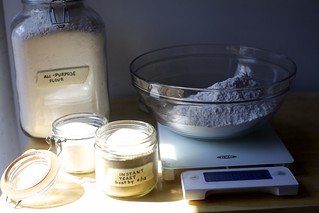
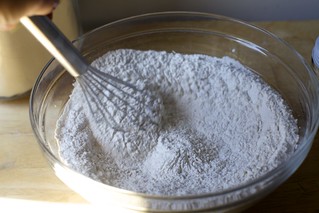
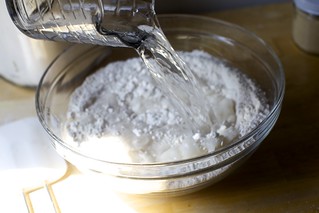
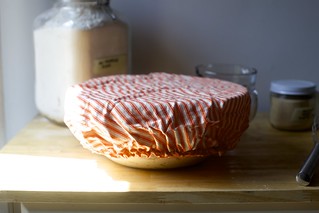
I realize you’re thinking, as I briefly worried before I read it, how does one write an entire cookbook based on one recipe? But Stafford is a gifted recipe developer, and there isn’t a thing in this book — one part breads (with all types of flours, grains, and shapes, including pizzas, flatbreads, rolls and buns), one part toasts (including sandwiches, tartines, stratas, panzanellas, soups, summer puddings and so much more), and one part crumbs (a celebration of crunchy gratin toppings, stuffing, burgers, eggplant parmesan, fish sticks, meatballs, and brown bettys) — that I didn’t want to make. (I suspect that having four kids to feed ensures that these recipes were vetted by the most finicky of reviewer classes.) It’s also a gorgeous book, with a focus and format that my inner, long-surrendered organized person finds deeply pleasing.
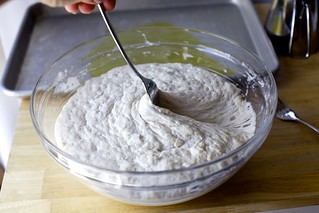
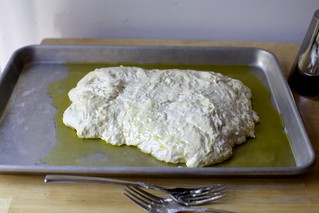
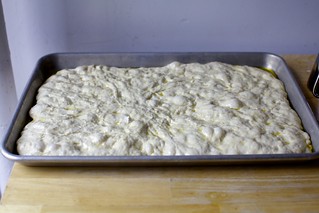

My favorite thing in the book, and the one that I come back to again and again, is using the core bread recipe to make a focaccia that can be split and filled to make a sheet pan’s worth of sandwiches.* File this under things I never thought about pre-kids but obsess over now: Picking up sandwiches to go to the beach/park/pool/wherever your summer weekend takes you for a family or group of friends can be staggeringly expensive. I might even forgive the price if the sandwiches were usually better, but I’m sorry-not-sorry, they’re usually not. Either the bread is lousy and processed to the hilt, or they just don’t make them the way I want them, which is heavy on the vegetables and with a good mix of fresh, salty, crunchy, and pickle-like ingredients. Let’s fix this.
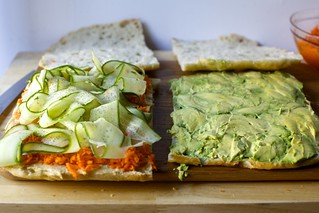
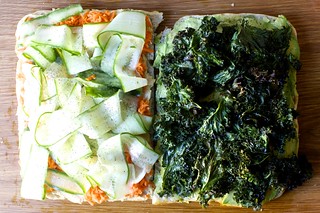
Below is the recipe for the simplest, quickest focaccia you’ll ever need to make and several sandwich filling suggestions (many vegan, too) I hope you’ll find good jumping off points.
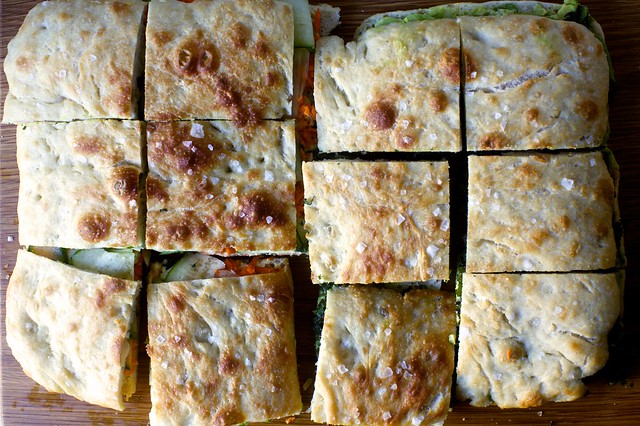
* If you have Smitten Kitchen Every Day at home (do you? I bet you’d love it, I’m just saying) you probably already know about my slab-sized sandwich fixation. In the book, I use roasted tomatoes and more to stuff a focaccia *before* it is baked, inspired by a foccia ripiena we ate in Rome several years ago. This is concept is similar, but there’s no need to pre-commit to fillings.
Previously
One year ago: Blackberry Blueberry Crumb Pie
Two years ago: Summer Squash Pizza and Peach Melba Popsicles
Three years ago: Raspberry Crushed Ice
Four years ago: Three-Ingredient Summertime Salsa and Blueberry Crumb Cake
Five years ago: Charred Corn Crepes and Burst Tomato Galette with Corn and Zucchini
Six years ago: Pink Lemonade Bars
Seven years ago: Tomato Salad with Crushed Croutons
Eight years ago: Nectarine Brown Butter Buckle and Sweet and Smoky Oven Spare Ribs
Nine years ago: Best Birthday Cake, Arugula Potato and Green Bean Salad and Peach and Creme Fraiche Pie
Ten years ago: Garlic Mustard Glazed Skewers and Huevos Rancheros
Eleven years ago: Quick Zucchini Saute
And for the other side of the world:
Six Months Ago: Chocolate Peanut Butter Cup Cookies and Slow-Roasted Sweet Potatoes
1.5 Years Ago: Broccoli Pizza
2.5 Years Ago: Spaghetti Pie with Pecorino and Black Pepper, Banana Puddings with Vanilla Bean Wafers, and Taco Torte
3.5 Years Ago: Caramelized Onion and Gruyere Biscuits and Charred Cauliflower Quesadillas
4.5 Years Ago: Garlicky Party Bread with Cheese and Herbs and Fennel and Blood Orange Salad
Focaccia Sandwiches for a Crowd
You can choose your own schedule with this bread, by proving it for 1 to 1 1/2 hours at room temperature, overnight in fridge, or 10 hours at room temperature. For the last option, you want to make the bread with cold tap water.
To use active dry yeast instead of instant yeast, add it directly to the lukewarm water with a pinch of sugar to proof it for 10 minutes (it will get foamy) and then add it below where you will the water.
For more of a traditional focaccia flavor, you can sprinkle 1 tablespoon chopped or minced fresh rosemary over the top with the salt before baking it.
- 4 cups (520 grams) all-purpose flour
- 2 teaspoons kosher salt
- 1 teaspoon instant yeast
- 2 cups lukewarm water, made by mixing 1/2 cup boiling water with 1 1/2 cups cold water
- 4 tablespoons olive oil
- Flaky sea salt
- In a large bowl, whisk together the flour, salt, and instant yeast. Add the water. Using a rubber spatula, mix until the water is absorbed and the ingredients form a loose, sticky dough. Cover with a tea towel or plastic wrap and [choose your schedule]:
- Quickest rise: Set aside in a warmish spot for 1 to 1 1/2 hours, until doubled.
- Overnight in fridge: Set inside your refrigerator overnight, about 8 to 10 hours.
- Overnight at room temperature: For this method, you will need to use only cold, no lukewarm, water. Leave the bowl on your counter at room temperature for 10 hours.
- Avocado + Crispy Kale [Shown]: First, crisp your kale. I used a 5-ounce clamshell of curly kale leaves, tearing out and discarding any thick ribs. Rub/toss them with 1 tablespoon olive oil, spread them on a large baking sheet in one layer, seasoned them with salt and pepper, and baked them at 375°F for 10 to 15 minutes, until crispy and just barely brown at the edges (keep an eye on it). Then, scoop out and slice 4 avocados, fan the slices across the bread and mash/spread them smooth. Coat with olive oil, lemon juice, flaky salt, and red pepper flakes (like we do here). Spread crispy kale over avocado.
- Hummus + Cucumber + Pickled Carrots [Shown]: First, coarsely grate 1 pound of carrots. Pour 1/2 cup apple cider vinegar, 1/2 cup cold water, 1 teaspoon kosher salt, and 1 to 2 teaspoons (to taste) of granulated sugar over it and stir to combine. (You could also add mustard or dill seeds or fresh chile peppers here.) Chill in the fridge for as long as you have — 30 minutes, an hour, and up to a few days. Carrots will get more pickled the longer it soaks. To make your sandwiches, schmear the bottom half of the bread with about 1 1/2 cups hummus (storebought or homemade). Squeeze out little handfuls of pickled carrot and sprinkle this on as your next layer. For you final layer, use a y-peeler to shave long ribbons off 1 large (1/2 to 3/4 pound) seedless cucumber. Tousel these on top; season them with salt and pepper.
- Walnut pesto + grilled zucchini ribbons (skip the parmesan in the pesto to make it vegan)
- This grilled pepper and torn mozzarella panzanella, minus the croutons
- This crunchy asparagus and egg salad
- Pickled vegetable sandwich slaw + anything else you love on sandwiches
- This salsa verde + any grilled or roasted vegetables
- This zucchini carpaccio salad, as a sandwich filling
- Any of the sandwiches from the archives
- Many of the salads from the archives, such as this egg salad, this chicken salad (not vegetarian, of course), that chicken salad, or even (I love this as a sandwich) this chicken caesar, with the dressing spread on both sides of the bread, the chicken thinly sliced, and the romaine cut into thin ribbons. I wouldn’t be sad to have a broccoli or cauliflower slaw between bread, either.
- Or, of course, endless slices of peak-season tomatoes + mayo + salt, or the same plus sliced mozzarella + basil pesto
When you’re ready to make your focaccia: Pour 3 tablespoons oil onto a rimmed sheet pan (can use a 13×18, or half-sheet pan, but if you have something more 11×17-ish, as I use here, will make for slightly thicker loaf; you can line it first with parchment paper for maximum nonstick security).
Heat oven to 425°F.
Using two forks, deflate the dough by releasing it from the sides of the bowl and pulling it toward the center. Rotate the bowl in quarter turns as you deflate, turning the mass into a rough ball. Use the forks to lift the dough onto the prepared sheet pan. Roll the dough ball in the oil to coat it all over.
Let dough rest for 20 minutes (for Quickest rise or Overnight at room temperature) or 1 hour (if you used the Overnight in the fridge rise, so it warms up) without touching it. Then, drizzle last 1 tablespoon of olive oil over and use your fingertips to stretch and press the dough to the edges, leaving it intentionally dimply. If your dough resists being stretched all the way, get it as stretched as you can, wait 5 minutes, and return to stretch it the rest of the way, repeating this rest if needed.
Sprinkle with flaky sea salt all over and bake for 20 to 25 minutes, checking in on the earlier end, until lightly puffed on top and golden and crisp underneath. Remove from oven and let cool completely (this will go faster if you transfer the bread to a cooling rack) before assembling sandwiches.
To make sandwiches: If you’d like, you can trim off the very outer edges — this exposes the crumb and makes it a little easier to halve. (I didn’t do this because I like to make things hard, also I like edges.) Stafford recommends you begin the halving process by cutting through each corner, then running the serrated knife through the short end until you get to the midway point, then starting from the other short end until I get to the midway point. A sharp, serrated knife is helpful. Try to keep your knife as parallel to the bread as possible. She says she finds if she hugs the top layer as opposed to aiming for the center, she gets a more even cut.
Some ideas for sandwich fillings:
Source: http://feedproxy.google.com/~r/smittenkitchen/~3/WVcYVnV_SpY/